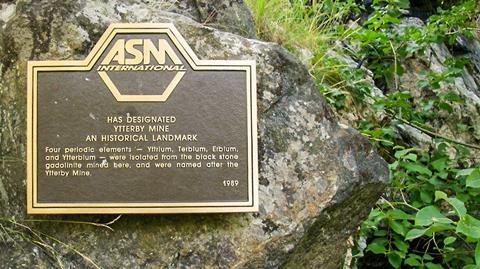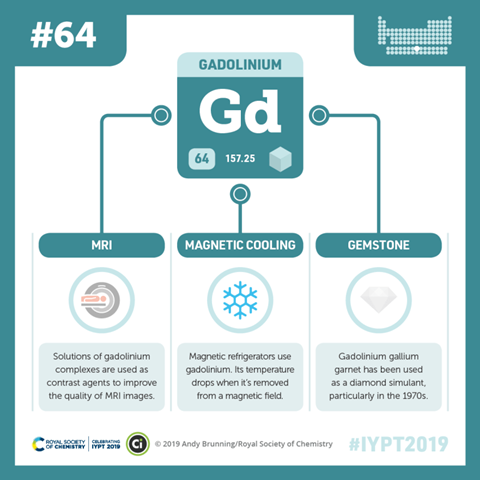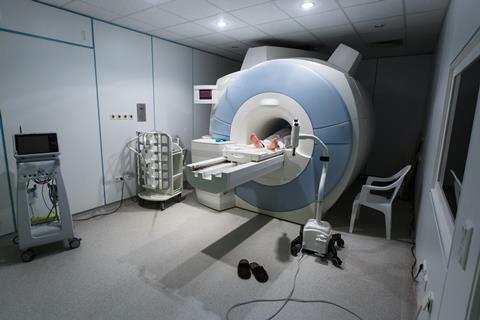Meera Senthilingham
This week: the art of naming an element. Here's Simon Cotton:
Simon Cotton
It's always interesting to know where an element takes its name. The family of elements that we call the lanthanides, or lanthanoids, have a somewhat random selection of names. That's because identifying the 15 lanthanide elements took over one hundred and fifty years, from the isolation of the first compounds to the synthesis of the last lanthanide, radioactive promethium, in 1947.
Some are named after gods, such as cerium; some like europium are named after places; and others including gadolinium, the star of this podcast, derive their names from scientists.

Gadolinium is named after Johan Gadolin, a Finnish scientist who was both a chemist and geologist. In 1792 he isolated the first rare earth compound, what we now know as yttrium oxide, from a black mineral that had been discovered at Ytterby in Sweden. A few years later this ore, which contained a number of lanthanides, was named gadolinite. Because of the difficulty in separating the very similar lanthanides, it was not until 1880 that a Swiss chemist named de Marignac identified spectroscopic lines due to the element we now know as gadolinium. Six years later, in 1886, the French chemist de Boisbaudran isolated the pure oxide, and called the element gadolinium, as it was obtained from gadolinite. Metallic gadolinium was not isolated until 1935, and like all the other lanthanides, it is a reactive metal.
Nearly all the known chemistry of gadolinium is that of the gadolinium three plus (3+) ion. This ion is colourless and does not at first glance seem very interesting. But like most other lanthanides and indeed transition metals, it has several unpaired electrons, giving it interesting magnetic properties. In fact this ion has 7 unpaired electrons in its 4f orbitals giving it a very large magnetic moment, and scientists are currently interested in making use of this.
As everyone knows, chlorofluorocarbons, CFCs for short, have been widely used in the past in fridges and freezers as the refrigerant gas. CFCs contribute to both depleting the Ozone layer and they are also Greenhouse gases, and due to this their use in the developed world has largely ceased. Meaning a good, more environmentally friendly, replacement is needed. Gadolinium may prove useful the fridges of the future due to a process known as magnetic refrigeration or adiabatic demagnetisation.

It works like this: When a substance containing unpaired electrons is put into a magnetic field, the magnetic dipoles tend to align with the field, in the lowest energy state; this process releases heat, which can be taken away using an external cooling liquid. Now if you remove the coolant from the magnetic material, and switch off the magnetic field. The magnetic dipoles in the material randomises, and it cools down.
A magnetic fridge has actually been constructed making use of gadolinium's ability to do this. The fridge contains a wheel with segments of powdered gadolinium, and as the wheel turns it passes through a gap between the poles of a very powerful magnet. When gadolinium is in the magnetic field it heats up, so it has to be cooled down by passing water through it.
Then as the wheel turns and the gadolinium leaves the magnetic field, the gadolinium starts to cools even more. A second lot of water is then flowed over the metal, which in turn is cooled down. This cool water is then circulated through the cooling coils of the fridge.
It's makers based at Iowa State University, say that this 'magnetic' refrigeration is 20 to 30 percent more energy efficient than conventional refrigeration – adding to its 'green' credentials.
That use may lie in the future, but the use of gadolinium in Magnetic Resonance Imaging is very much in the present.
MRI is a routine non-invasive clinical method used to produce two-dimensional images of our tissues or organs for diagnostic purposes. When searching for blood vessels or tumours, contrast agents are injected intravenously to improve the image quality of the MRI signal, and these are normally aqueous solutions of gadolinium complexes.

The free Gd3+ ion has a similar ionic radius to Ca2+ but a greater charge, so gadolinium itself can not be used as it might interfere with various calcium roles in signalling within the body and therefore be toxic. So the gadolinium ions are turned into stable complexes before being used, by reacting them with ligands like diethylenetriamine pentacetic acid, known as DPTA. This ligand has 8 atoms to attach to gadolinium, meaning it is bound very tightly indeed, ensuring free, toxic, gadolinium is not released. Once injected the compound circulates though the vascular system and then is filtered out through the kidneys and excreted unchanged. All the evidence suggests that it is quite safe, but at present its use in pregnant women is discouraged, largely because its safety for the foetus has not been proved.
So Gadolinium – colourless and initially may not sound very interesting, but may hold the key to keeping your milk or butter cool without damaging our environment and may even help save your life.
Meera Senthilingham
So offering the potential to save our lives and the environment – quite an element. That was Uppingham School's Simon Cotton with the heroic chemistry of gadolinium. Now, next week, we go back to the importance of naming an element, but also its pronunciation.
Brian Clegg
You'd think it is pretty strightforward to decide what an element is called, but element 102 has had more than its fair share of misunderstandings and arguments. To begin with, there's the matter of how to pronounce its current name: no-bell-ium, as it comes from the same root as the Nobel prize; or no-beel-ium, modelled on the way we say 'helium'. Even the Royal Society of Chemistry's representatives had a raging discussion on this when I asked them, before plumping for no-beel-ium. And that's just the pronunciation, the name itself took a fair amount of sorting out.
Meera Senthilingham
And join Brian Clegg to find out how element 102 received its name, as well as the wonders of its chemistry, in next week's Chemistry in its element. Until then, thank you for listening, I'm Meera Senthilingham.













No comments yet